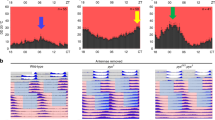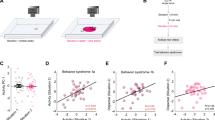Abstract
The core mechanism of circadian timekeeping in arthropods and vertebrates consists of feedback loops involving several clock genes, including period (per) and timeless (tim)1,2. In the fruitfly Drosophila, circadian oscillations in per expression occur in chemosensory cells of the antennae, even when the antennae are excised and maintained in isolated organ culture3. Here we demonstrate a robust circadian rhythm in Drosophila in electrophysiological responses to two classes of olfactory stimuli. These rhythms are observed in wild-type flies during light–dark cycles and in constant darkness, but are abolished in per or tim null-mutant flies (per01 and tim01) which lack rhythms in adult emergence and locomotor behaviour. Olfactory rhythms are also abolished in the per 7.2:2 transgenic line in which per expression is restricted to the lateral neurons of the optic lobe4. Because per 7.2:2 flies do not express per in peripheral oscillators, our results provide evidence that peripheral circadian oscillators are necessary for circadian rhythms in olfactory responses. As olfaction is essential for food acquisition, social interactions and predator avoidance in many animals, circadian regulation of olfactory systems could have profound effects on the behaviour of organisms that rely on this sensory modality.
This is a preview of subscription content, access via your institution
Access options
Subscribe to this journal
Receive 51 print issues and online access
$199.00 per year
only $3.90 per issue
Buy this article
- Purchase on Springer Link
- Instant access to full article PDF
Prices may be subject to local taxes which are calculated during checkout




Similar content being viewed by others
References
Hardin, P. E. Activating inhibitors and inhibiting activators: A day in the life of a fly. Curr. Opin. Neurobiol. 8, 642–647 (1998).
Dunlap, J. C. Molecular basis for circadian clocks. Cell 96, 271–290 (1999).
Plautz, J. D., Kaneko, M., Hall, J. C. & Kay, S. A. Independent photoreceptive circadian clocks throughout Drosophila. Science 278, 1632–1635 (1997).
Frisch, B., Hardin, P. E., Hamblen-Coyle, M. J., Rosbash, M. & Hall, J. C. Apromoterless period gene mediates behavioral rhythmicity and cyclical per expression in a restricted subset of the Drosophila nervous system. Neuron 12, 555–570 (1994).
Alcorta, E. Characterization of the electroantennogram in Drosophila melanogaster and its use for identifying olfactory capture and transduction mutants. J. Neurophysiol. 65, 702–714 (1991).
Ayer, R. K. & Carlson, J. R. Olfactory physiology in Drosophila antenna and maxillary palp: Acj6 distinguishes two classes of odorant pathways. J. Neurobiol. 23, 965–982 (1992).
Dubin, A. E., Heald, N. L., Cleveland, B., Carlson, J. R. & Harris, G. L. Scutoid mutation of Drosophila melanogaster specifically decreases olfactory responses to short-chain acetate esters and ketones. J. Neurobiol. 28, 214–233 (1995).
Anholt, R. R., Lyman, R. F. & Mackay, T. F. Effects of single P-element insertions on olfactory behavior in Drosophila melanogaster. Genetics 143, 293–301 (1996).
Qiu, J. & Hardin, P. E. per mRNA cycling is locked to lights-off under photoperiodic conditions that support circadian feedback loop function. Mol. Cell. Biol. 6, 4182–4188 (1996).
Marrus, S. B., Zheng, H. & Rosbash, M. Effect of constant light and circadian entrainment of perS flies: Evidence for light-mediated delay of the negative feedback loop in Drosophila. EMBO J. 15, 6877–6886 (1996).
Sakamoto, K.et al. Multitissue circadian expression of rat period homolog (rPer2) mRNA is governed by the mammalian circadian clock, the suprachiasmatic nucleus in the brain. J. Biol. Chem. 273, 27039–27042 (1998).
Konopka, R. J. & Benzer, S. Clock mutants of Drosophila melanogaster. Proc. Natl Acad. Sci. USA 68, 2112–2116 (1971).
Hall, J. C. The mating of a fly. Science 264, 1702–1714 (1994).
Tully, T. & Quinn, W. G. Classical conditioning and retention in normal and mutant Drosophila melanogaster. J. Comp. Physiol. A 157, 263–277 (1985).
Davis, R. L. Physiology and biochemistry of Drosophila learning mutants. Physiol. Rev. 76, 299–317 (1996).
Suri, V., Qian, Z., Hall, J. C. & Rosbash, M. Evidence that the TIM light response is relevant to light-induced phase shifts in Drosophila melanogaster. Neuron 21, 225–234 (1998).
Acknowledgements
This work was supported by grants from the NIH to S.E.D. and P.E.H. B.K. received support from the BRAIN program. We thank L.Dryer and N. Glossop for discussions and comments on the manuscript. S.E.D. and P.E.H. are NHTS.
Author information
Authors and Affiliations
Corresponding author
Rights and permissions
About this article
Cite this article
Krishnan, B., Dryer, S. & Hardin, P. Circadian rhythms in olfactory responses of Drosophila melanogaster. Nature 400, 375–378 (1999). https://doi.org/10.1038/22566
Received:
Accepted:
Issue Date:
DOI: https://doi.org/10.1038/22566
This article is cited by
-
Males of Aedes aegypti show different clock gene expression profiles in the presence of conspecific females
Parasites & Vectors (2022)
-
Impact of disabled circadian clock on yellow fever mosquito Aedes aegypti fitness and behaviors
Scientific Reports (2022)
-
Metabolism and growth adaptation to environmental conditions in Drosophila
Cellular and Molecular Life Sciences (2020)
-
Evidence of nanoemulsion as an effective control measure for fruit flies Drosophila melanogaster
Scientific Reports (2019)
-
Circadian clocks of both plants and pollinators influence flower seeking behavior of the pollinator hawkmoth Manduca sexta
Scientific Reports (2018)
Comments
By submitting a comment you agree to abide by our Terms and Community Guidelines. If you find something abusive or that does not comply with our terms or guidelines please flag it as inappropriate.



